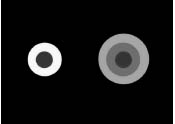Michael E. Rudd & Karl Frederick Arrington
Vision Research
2001; 41(27), p. 3649-3662.

|
Michael E. Rudd & Karl Frederick Arrington Vision Research |
 |
||
Download PDF |
|||
A model of darkness induction based on a neural filling-in mechanism is proposed. The model borrows principles from both Land's Retinex theory and BCS/FCS filling-in model of Grossberg and colleagues. The main novel assumption of the induction model is that darkness filling-in signals, which originate at luminance borders, are partially blocked when they try to cross other borders. The percentage of the filling-in signal that is blocked is proportional to the log luminance ratio across the border that does the blocking. The model is used to give a quantitative account of the data from a brightness matching experiment in which a decremental test disk was surrounded by two concentric rings. The luminances of the rings were independently varied to modulate the brightness of the test. Observers adjusted the luminance of a comparison disk surrounded by a single ring of higher luminance to match the test disk in brightness.
Brightness; Brightness induction; Filling-in; Lightness; Retinex theory